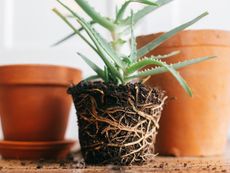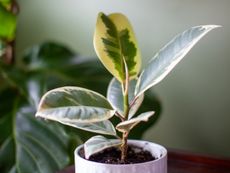Growing Houseplant Runners: Tips For Propagating Runners On Houseplants


Some houseplant propagation is achieved through seeds while others can be grown via runners. Propagating houseplants with runners produces a replica of the parent plant, so a healthy parent is absolutely necessary. Keep reading to find out how to propagate runners on houseplants.
Propagating Houseplants with Runners by Layering
When you propagate from runners and arching stems, it's called layering. Ivy (Hedera spp.) and other climbers can be reproduced this way. Make sure you water the plant well the day before you choose to perform this method of propagating houseplants. Place a pot filled with cutting compost next to the parent plant. Fold a stem near a node (without cutting it off) to form a 'V' in the stem. Anchor the V of the stem into the compost with bent wire. Firm the compost from above and water the compost. Keep the compost moist. This helps the roots develop faster and better. When you see fresh growth at the tip of the stem, roots have been established and you can remove the new plant from its mother.
Air Layering Houseplant Propagation
Air layering is another way to propagate runners on houseplants and a great way to give a tall, leggy plant that's lost its lower leaves a new lease on life. This is often used on rubber plant (Ficus elastica) and sometimes on dieffenbachia, dracaena, and monstera. All air layering involves is encouraging roots to develop just below the lowest leaf. When there are roots established, the stem can be severed and the new plant repotted. This is, however, not a fast way to propagate houseplants. Again, be sure to water the plant the day before. Then, using a sharp knife, make an upward cut two-thirds through the stem and 8 to 10 cm (3 to 4 in.) below the lowest leaf. Make sure you don't bend and break the top of the plant. Use a matchstick to keep the surfaces of the cut apart. If you don't, the wound will heal and it will not readily form roots. You will want to trim the ends off the matchsticks and use a small brush to coat the plant surfaces with rooting powder. After that, take a piece of polythene and wind it around the stem with the cut area in the center. Make sure your string is strong and tie it about 5 cm. (2 in.) below the cut. Wind the string around several times to hold it. Carefully fill the polythene with moist peat. Fill it to within 8 cm (3 in.) of the top and tie it off. It acts as a bandage. Take the plant and place it in gentle warmth and shade. Within two months, roots will show through the polythene. While the roots are still white, cut the stem below the tube. Remove the polythene and string. Keep as much of the peat in the polythene as possible for repotting. By using these methods to propagate houseplants, you can increase the number of plants you have for your personal use or share them with family and friends.
Gardening tips, videos, info and more delivered right to your inbox!
Sign up for the Gardening Know How newsletter today and receive a free download of our most popular eBook "How to Grow Delicious Tomatoes."

Heather Rhoades founded Gardening Know How in 2007. She holds degrees from Cleveland State University and Northern Kentucky University. She is an avid gardener with a passion for community, and is a recipient of the Master Gardeners of Ohio Lifetime Achievement Award.
-
 Want a Backyard Mini Orchard? Create Your Own Container Orchard
Want a Backyard Mini Orchard? Create Your Own Container OrchardEasier to care for in small spaces, a backyard mini-orchard makes sense for busy gardeners and juicy fruit is the reward.
By Teo Spengler
-
 Urban Beekeeping Guide: Top Tips For Raising Bees In The City
Urban Beekeeping Guide: Top Tips For Raising Bees In The CityUrban beekeeping can be a rewarding and appreciated pastime, but first be sure it’s legal in your city and learn the ropes of beekeeping.
By Mary Ellen Ellis
-
 8 Easy Care Houseplants That Live A Long Time
8 Easy Care Houseplants That Live A Long TimeClick here to learn about our 8 favorite low maintenance houseplants that can, with proper care, live a long time.
By Amy Grant
-
 How Often Should You Repot Plants?
How Often Should You Repot Plants?Escaping roots and shrinking leaves may mean your plant wants a new pot, but some like staying cramped and cozy.
By Mary Ellen Ellis
-
 Orange Flowering Houseplant Varieties With Tropical Flair
Orange Flowering Houseplant Varieties With Tropical FlairClick here to learn about some cheerful orange-blooming houseplants you can try growing.
By Mary Ellen Ellis
-
 Variegated Houseplants With Lovely Leaves
Variegated Houseplants With Lovely LeavesWhat are some of the best variegated houseplants to add to your collection? Click here to find out.
By Amy Grant
-
 Lovely, Lacy Indoor Foliage Plants
Lovely, Lacy Indoor Foliage PlantsClick here to learn about some houseplants with lacy foliage to add to your collection.
By Mary Ellen Ellis
-
 Best Christmas Houseplants And Plants For Winter Holidays
Best Christmas Houseplants And Plants For Winter HolidaysClick here for an idea of the best houseplants to use for holiday décor for Christmas, Hanukkah, Kwanzaa, and New Year’s.
By Laura Miller
-
 Best Big Houseplants To Create An Indoor Oasis
Best Big Houseplants To Create An Indoor OasisIf you have the space you may want to grow some large houseplants. Here are some ideas.
By Mary Ellen Ellis
-
 Relaxing Plants To Grow Indoors For A Calmer Mind
Relaxing Plants To Grow Indoors For A Calmer MindAre there houseplants that can help you to relax? Click here to find out.
By Laura Miller